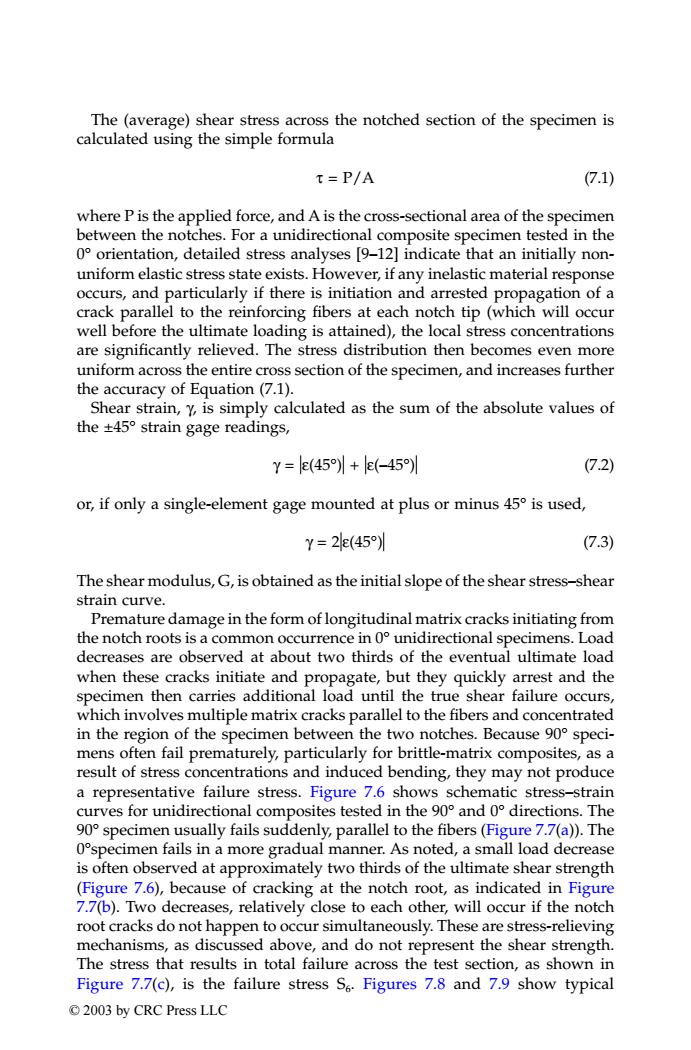正在加载图片...

The(average)shear stress across the notched section of the specimen is calculated using the simple formula t=P/A (7.1) where P is the applied force,and A is the cross-sectional area of the specimen between the notches.For a unidirectional composite specimen tested in the 0 orientation,detailed stress analyses [9-12]indicate that an initially non- uniform elastic stress state exists.However,if any inelastic material response occurs,and particularly if there is initiation and arrested propagation of a crack parallel to the reinforcing fibers at each notch tip (which will occur well before the ultimate loading is attained),the local stress concentrations are significantly relieved.The stress distribution then becomes even more uniform across the entire cross section of the specimen,and increases further the accuracy of Equation(7.1). Shear strain,Y,is simply calculated as the sum of the absolute values of the±45°strain gage readings, Y=e(45)+e(-45) (7.2) or,if only a single-element gage mounted at plus or minus 45 is used, Y=2ke(45 (7.3) The shear modulus,G,is obtained as the initial slope of the shear stress-shear strain curve. Premature damage in the form of longitudinal matrix cracks initiating from the notch roots is a common occurrence in 0 unidirectional specimens.Load decreases are observed at about two thirds of the eventual ultimate load when these cracks initiate and propagate,but they quickly arrest and the specimen then carries additional load until the true shear failure occurs, which involves multiple matrix cracks parallel to the fibers and concentrated in the region of the specimen between the two notches.Because 90 speci- mens often fail prematurely,particularly for brittle-matrix composites,as a result of stress concentrations and induced bending,they may not produce a representative failure stress.Figure 7.6 shows schematic stress-strain curves for unidirectional composites tested in the 90 and 0 directions.The 90 specimen usually fails suddenly,parallel to the fibers(Figure 7.7(a)).The 0specimen fails in a more gradual manner.As noted,a small load decrease is often observed at approximately two thirds of the ultimate shear strength (Figure 7.6),because of cracking at the notch root,as indicated in Figure 7.7(b).Two decreases,relatively close to each other,will occur if the notch root cracks do not happen to occur simultaneously.These are stress-relieving mechanisms,as discussed above,and do not represent the shear strength. The stress that results in total failure across the test section,as shown in Figure 7.7(c),is the failure stress S.Figures 7.8 and 7.9 show typical ©2003 by CRC Press LLCThe (average) shear stress across the notched section of the specimen is calculated using the simple formula τ = P/A (7.1) where P is the applied force, and A is the cross-sectional area of the specimen between the notches. For a unidirectional composite specimen tested in the 0° orientation, detailed stress analyses [9–12] indicate that an initially nonuniform elastic stress state exists. However, if any inelastic material response occurs, and particularly if there is initiation and arrested propagation of a crack parallel to the reinforcing fibers at each notch tip (which will occur well before the ultimate loading is attained), the local stress concentrations are significantly relieved. The stress distribution then becomes even more uniform across the entire cross section of the specimen, and increases further the accuracy of Equation (7.1). Shear strain, γ, is simply calculated as the sum of the absolute values of the ±45° strain gage readings, γ = ε(45°) + ε(–45°) (7.2) or, if only a single-element gage mounted at plus or minus 45° is used, γ = 2ε(45°) (7.3) The shear modulus, G, is obtained as the initial slope of the shear stress–shear strain curve. Premature damage in the form of longitudinal matrix cracks initiating from the notch roots is a common occurrence in 0° unidirectional specimens. Load decreases are observed at about two thirds of the eventual ultimate load when these cracks initiate and propagate, but they quickly arrest and the specimen then carries additional load until the true shear failure occurs, which involves multiple matrix cracks parallel to the fibers and concentrated in the region of the specimen between the two notches. Because 90° specimens often fail prematurely, particularly for brittle-matrix composites, as a result of stress concentrations and induced bending, they may not produce a representative failure stress. Figure 7.6 shows schematic stress–strain curves for unidirectional composites tested in the 90° and 0° directions. The 90° specimen usually fails suddenly, parallel to the fibers (Figure 7.7(a)). The 0°specimen fails in a more gradual manner. As noted, a small load decrease is often observed at approximately two thirds of the ultimate shear strength (Figure 7.6), because of cracking at the notch root, as indicated in Figure 7.7(b). Two decreases, relatively close to each other, will occur if the notch root cracks do not happen to occur simultaneously. These are stress-relieving mechanisms, as discussed above, and do not represent the shear strength. The stress that results in total failure across the test section, as shown in Figure 7.7(c), is the failure stress S6. Figures 7.8 and 7.9 show typical TX001_ch07_Frame Page 109 Saturday, September 21, 2002 4:58 AM © 2003 by CRC Press LLC������